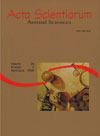<b>Laboratorial system of carbohydrate fractions of energetic concentrate</b> - DOI: 10.4025/actascianimsci.v28i2.652
Abstract
The aim of this work was to evaluate a laboratorial system of carbohydrate fractions to identify and quantify the fractions that compose this nutrient. The following fractions were determined: simple sugars (SS) using the colorimetric phenol-sulfuric method; digestible starch (DS) and resistant starch (RS) by enzymatic digestions; total fiber (TF) using the enzymic-gravimetric method; neutral detergent fiber (NDF) and soluble fiber (SF) estimated by difference TF - NDF, in grains of corn and sorghum, citric pulp, wheat middlings, wheat mills and rice bran. The coefficient of variation for fractions SS, DS, RS, TF and NDF varied from 4.81 to 19.17%; 4.58 to 15.03%; 2.42 to 9.91%; 1.23 to 8.23% and 1.16 to 8.42%; respectively. A good repeatability of the method used was observed. The fraction identified the main groups of carbohydrates composed on the food and it can be a reference to future works.Downloads
Download data is not yet available.
Published
2008-02-15
How to Cite
Lima, R. F. de, Gonçalves, M. B. F., Silva, L. P. da, Nornberg, J. L., & Almeida, H. S. L. de. (2008). <b>Laboratorial system of carbohydrate fractions of energetic concentrate</b> - DOI: 10.4025/actascianimsci.v28i2.652. Acta Scientiarum. Animal Sciences, 28(2), 215-221. https://doi.org/10.4025/actascianimsci.v28i2.652
Issue
Section
Ruminant Nutrition
DECLARATION OF ORIGINALITY AND COPYRIGHTS
- I Declare that current article is original and has not been submitted for publication, in part or in whole, to any other national or international journal.
The copyrights belong exclusively to the authors. Published content is licensed under Creative Commons Attribution 4.0 (CC BY 4.0) guidelines, which allows sharing (copy and distribution of the material in any medium or format) and adaptation (remix, transform, and build upon the material) for any purpose, even commercially, under the terms of attribution.
Read this link for further information on how to use CC BY 4.0 properly.
0.9
2019CiteScore
29th percentile
Powered by 








































